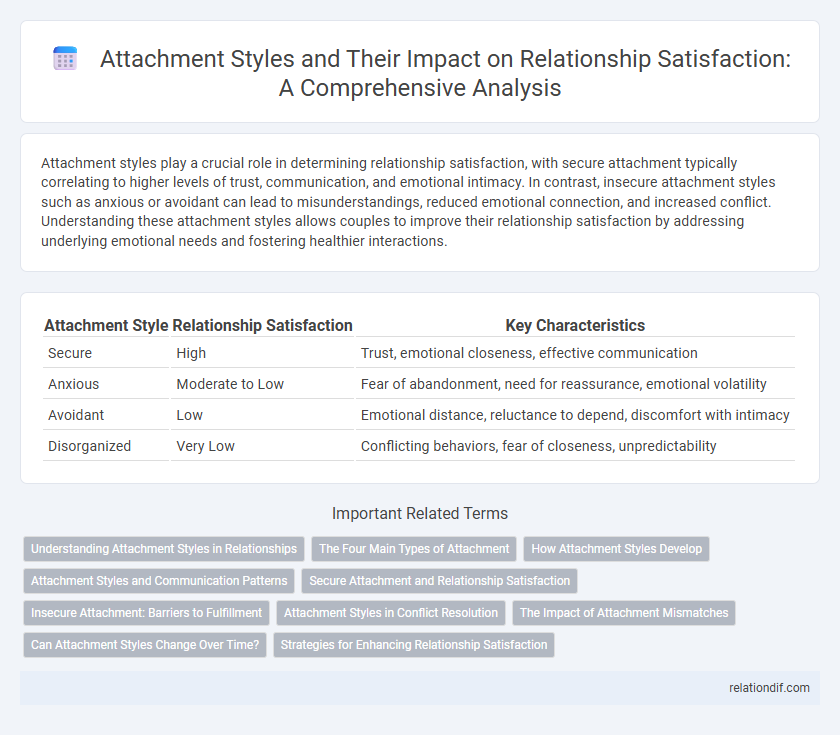Attachment styles play a crucial role in determining relationship satisfaction, with secure attachment typically correlating to higher levels of trust, communication, and emotional intimacy. In contrast, insecure attachment styles such as anxious or avoidant can lead to misunderstandings, reduced emotional connection, and increased conflict. Understanding these attachment styles allows couples to improve their relationship satisfaction by addressing underlying emotional needs and fostering healthier interactions.
Table of Comparison
| Attachment Style | Relationship Satisfaction | Key Characteristics |
|---|---|---|
| Secure | High | Trust, emotional closeness, effective communication |
| Anxious | Moderate to Low | Fear of abandonment, need for reassurance, emotional volatility |
| Avoidant | Low | Emotional distance, reluctance to depend, discomfort with intimacy |
| Disorganized | Very Low | Conflicting behaviors, fear of closeness, unpredictability |
Understanding Attachment Styles in Relationships
Attachment styles, including secure, anxious, avoidant, and disorganized, significantly influence relationship satisfaction by shaping emotional bonds and communication patterns. Secure attachment promotes trust and intimacy, leading to higher relationship quality, while anxious and avoidant styles often result in misunderstandings and conflict. Understanding these attachment patterns enables partners to improve empathy, manage expectations, and foster healthier, more satisfying relationships.
The Four Main Types of Attachment
The four main attachment styles--secure, anxious, avoidant, and disorganized--significantly influence relationship satisfaction by shaping emotional intimacy and conflict resolution patterns. Securely attached individuals typically experience higher satisfaction due to trust and effective communication, while anxious and avoidant styles often correlate with lower satisfaction because of fear of abandonment or emotional distance. Disorganized attachment, characterized by inconsistent behaviors, frequently leads to confusion and instability, severely impacting overall relationship fulfillment.
How Attachment Styles Develop
Attachment styles develop during early childhood through interactions with primary caregivers, shaping individuals' expectations and behaviors in adult relationships. Secure attachment forms when caregivers provide consistent support and responsiveness, fostering trust and emotional regulation. Insecure attachment styles, such as anxious or avoidant, arise from inconsistent or neglectful caregiving, often leading to challenges in relationship satisfaction and intimacy.
Attachment Styles and Communication Patterns
Attachment styles significantly influence communication patterns in relationships, shaping how partners express needs, resolve conflicts, and provide support. Secure attachment promotes open, honest dialogue and effective emotional regulation, leading to higher relationship satisfaction. In contrast, anxious and avoidant attachment styles often result in miscommunication, withdrawal, or excessive reassurance-seeking, which can undermine relational stability and satisfaction.
Secure Attachment and Relationship Satisfaction
Secure attachment is strongly correlated with higher relationship satisfaction due to the ability to establish trust, effective communication, and emotional intimacy. Individuals with secure attachment styles typically exhibit lower conflict levels and greater resilience in handling relationship challenges. Research consistently highlights that secure attachment fosters stable, supportive, and fulfilling romantic partnerships.
Insecure Attachment: Barriers to Fulfillment
Insecure attachment styles, such as anxious and avoidant types, present significant barriers to relationship satisfaction by fostering mistrust, emotional distance, and heightened conflict. These attachment patterns hinder effective communication and intimacy, reducing partners' ability to resolve disagreements and meet each other's emotional needs. Research shows that individuals with insecure attachment report lower satisfaction due to persistent fears of abandonment or rejection, which undermine long-term fulfillment and stability.
Attachment Styles in Conflict Resolution
Attachment styles significantly influence conflict resolution strategies and directly impact relationship satisfaction. Secure attachment fosters effective communication and empathy, leading to constructive conflict resolution and higher relationship satisfaction. In contrast, anxious and avoidant attachment styles often result in maladaptive conflict behaviors, such as withdrawal or aggression, decreasing overall relationship quality and satisfaction.
The Impact of Attachment Mismatches
Attachment mismatches, where partners exhibit differing attachment styles such as anxious and avoidant, significantly reduce relationship satisfaction by fostering misunderstandings and emotional distance. Research indicates that secure-secure pairings consistently report higher relationship satisfaction compared to anxious-avoidant or anxious-anxious combinations. Addressing attachment mismatches through targeted interventions can improve communication and emotional connection, enhancing overall relationship quality.
Can Attachment Styles Change Over Time?
Attachment styles, typically categorized as secure, anxious, avoidant, or disorganized, can evolve through life experiences, therapy, and changing relationship dynamics, influencing overall relationship satisfaction. Research indicates that increased self-awareness and emotional regulation contribute to shifts from insecure to more secure attachment patterns, which correlate positively with greater relationship satisfaction. Consistent positive interactions and emotional support within partnerships foster this transformation, enhancing long-term relational stability and fulfillment.
Strategies for Enhancing Relationship Satisfaction
Secure attachment promotes open communication, empathy, and trust, which significantly boost relationship satisfaction. Couples with anxious or avoidant attachment styles benefit from therapy and mindfulness practices to improve emotional regulation and foster intimacy. Building consistent support systems and practicing vulnerability enhances connection and overall relationship fulfillment.
Attachment styles vs relationship satisfaction Infographic

 relationdif.com
relationdif.com